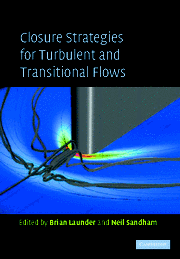9 - Introduction to Two-Point Closures
Published online by Cambridge University Press: 06 July 2010
Summary
Abstract
An overview is given of nonlocal theories and models, ranging from linear to nonlinear. The background principles are presented and illustrated mainly for incompressible, homogeneous, anisotropic turbulence. In this case, which includes effects of mean gradients and body forces and related structural effects, the complete rapid distortion theory (RDT)solution is shown to be a building block for constructing a full nonlinear closure theory. Firstly, a general overview of the closure problem is presented, which accounts for both the nonlinear problem and the nonlocal problem. Then, some limitations of single-point closures are illustrated by simple examples, and we discriminate flows dominated by production effects and flows dominated by wave effects. A classical spectral description is introduced for the fluctuating flow and its multi-point correlations. Applications to stably-stratified and rotating turbulence are discussed. Linear effects captured by RDT include dispersivity of gravity waves, whereas the irreversible collapse of vertical motion and subsequent layering of the velocity field is only captured by nonlinear theories or high resolution DNS/LES computations. Applications to weak turbulence in compressible flows are touched upon at the very end.
Introduction
Two-point statistical closures (Direct Interaction Approximation, DIA, Eddy Damped Quasi Normal Markovian, EDQNM, and the Test Field Model, TFM) were initially mainly developed for the special case of homogeneous, isotropic turbulence during the ground-breaking studies of the 60s and 70s (see e.g. Kraichnan 1959, Orszag 1970, Monim and Yaglom 1975, among many others), but have since then been extended to some anisotropic and even inhomogeneous flows, areas in which work continues today.
Although such models are aimed at strongly nonlinear turbulence, their mathematical structure is closely related to that of linear or weakly nonlinear theories (see Cambon and Scott 1999, and references therein). For example, the theory of weak turbulence (see Benney and Saffman 1966, and [26]), which has recently seen considerable interest in the geophysical context, presents strong similarities with two-point closures, even if very few studies illustrating the connections between the two approaches have appeared to date. Thus, the case of anisotropic, incompressible, homogeneous turbulence subject to different anisotropizing influences, such as rotation or stratification, and of weakly compressible turbulence, even in the isotropic case, present challenges which are currently being addressed using both two-point techniques and asymptotic theories of weak turbulence.
- Type
- Chapter
- Information
- Closure Strategies for Turbulent and Transitional Flows , pp. 299 - 327Publisher: Cambridge University PressPrint publication year: 2002



